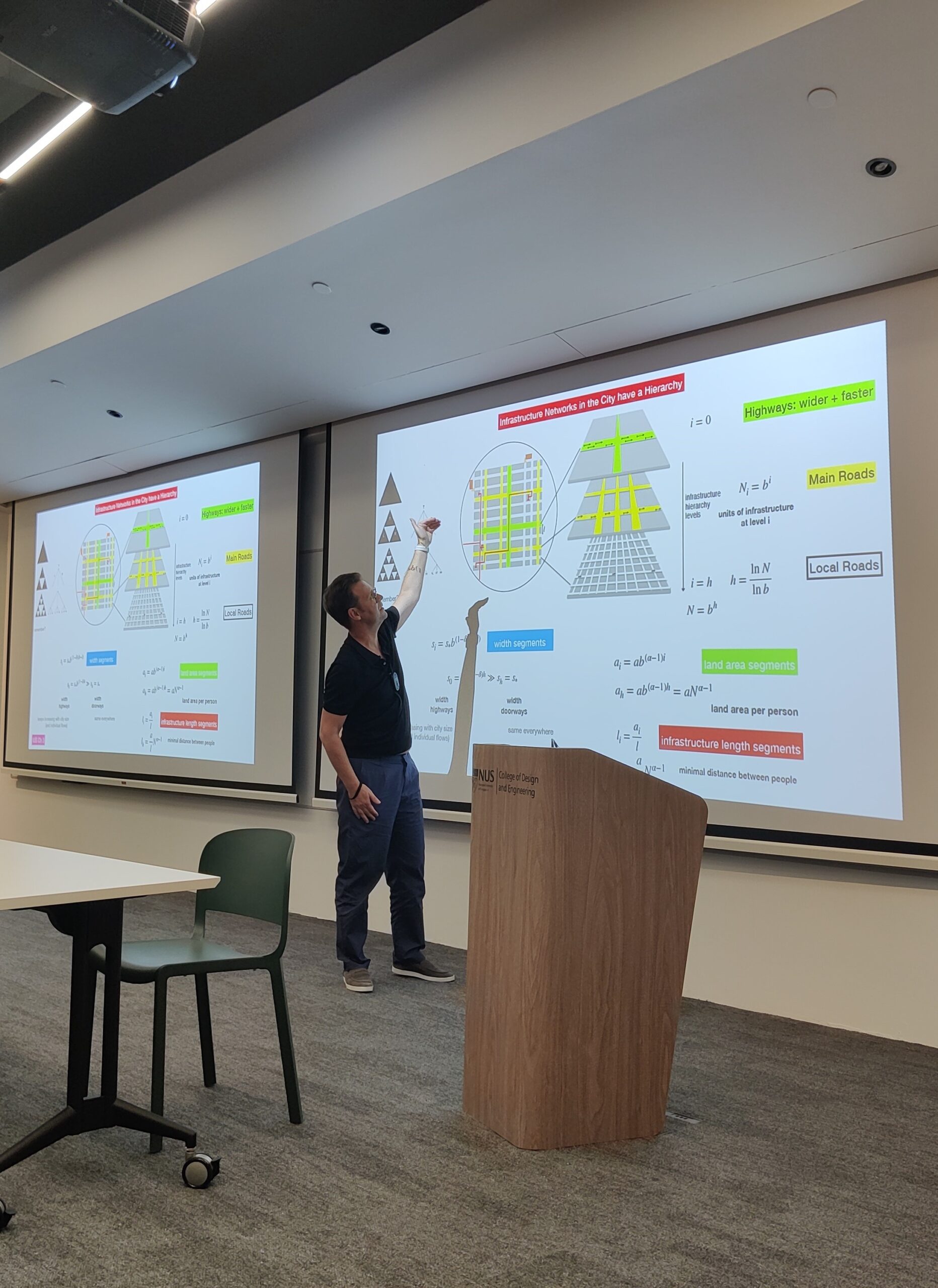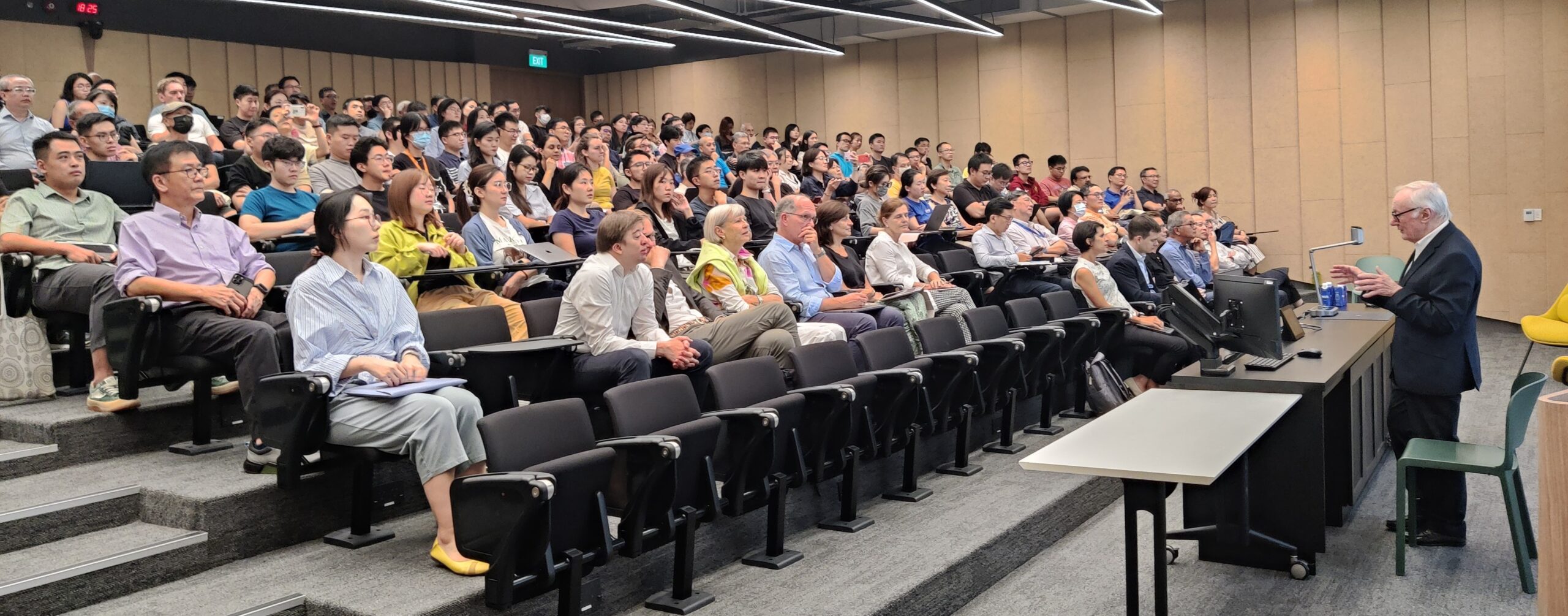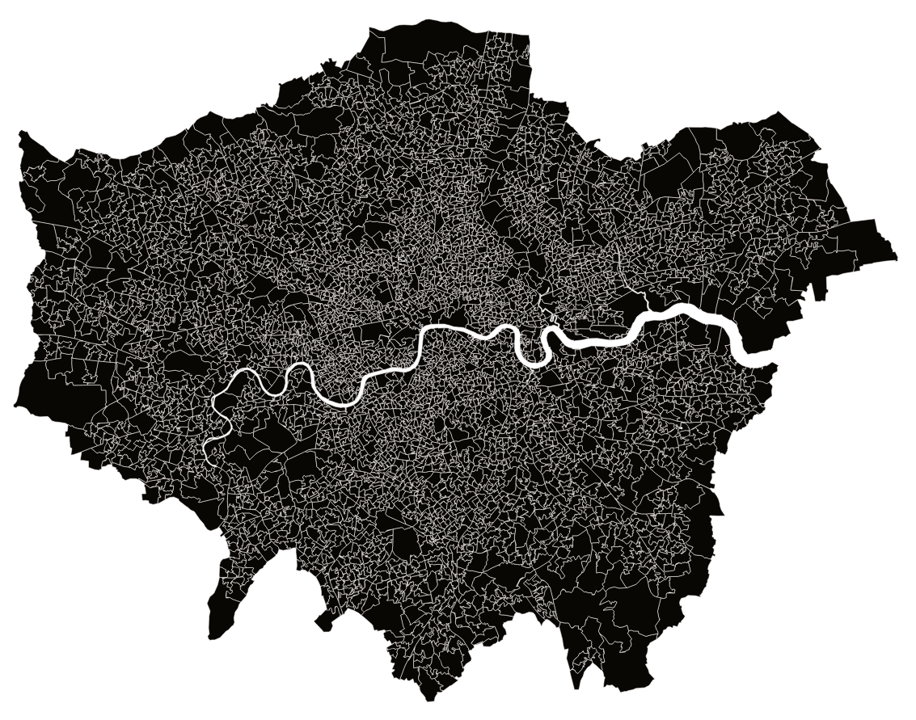REVIEW
The Science(s) of Cities?
On 3 August 2023, Professors Michael Batty (Chair, Centre for Advanced Spatial Analysis (CASA), University College London) and Luis Bettencourt (Professor of Ecology and Evolution, University of Chicago; and former Inaugural Director, Mansueto Institute for Urban Innovation), both spoke at the third instalment of the NUS Cities Lecture Series.. As pioneers in the emerging field of urban science, having authored comprehensive monographs on the subject (e.g. Batty’s The New Science of Cities and Bettencourt’s Introduction to Urban Science), the two professors spoke on ‘Complexity in Cities’. Here are key insights from their lectures.

The ethical imperative (Why a science of cities?)
Contrary to some claims that cities are sites doomed to squalor, pollution and human misery, the data shows that cities have been key drivers in human socio-economic development. The larger the city, the larger the economy of the city per capita. Larger cities and denser cities have been shown to allow for more social interactions leading to greater professional specialisation, innovation and the potential for lower rates of depression, for example. The transformation of cities like Singapore and Shanghai, amongst others, has shown the potential for urban development to lift thousands, even millions, out of poverty. However, the previous century has also shown how dreams of urban utopia have failed to deliver the happiness and benefits hoped for. Le Corbusier’s idea of the Radiant City provided a model for a supposedly functional city centred, and connected, by highways and cars, but which lacked attention to people’s needs and the diversity necessary for a city with vitality and heart. Recent attempts at building the ‘smart city’, such as Alphabet’s Sidewalk Labs project in Toronto have only resulted in a sceptical backlash, so much so that one online article has been titled ‘Toronto wants to kill the smart city forever’. Prof Bettencourt emphasised how, at the root of all these troubles, is a fundamental lack of understanding of how cities work, and a misplaced focus on technology and the design of the built environment as the panaceas that make good cities. The study of cities needs to be placed on a new footing, focusing on the needs of the people who live in them, with technology and the built environment as enablers of social, economic and civic life. Given the potential of cities to achieve human well-being, this renewal of the science of cities is intrinsically also important for moral and ethical reasons. As Prof Bettencourt concluded his lecture:
…without understanding this process [of urbanisation] in a way that generalises and takes you to different places in Africa, India and in all the places that are the frontiers of this development, we will not have the chance to guide those processes sufficiently quickly towards a happier, more fulfilled, and more sustainable life for most people on the planet while managing the major challenges of the decades ahead.
The current opportunities (Why now for a science of cities?)
For Prof Batty, one way to explore the complexity of cities is through the creation of multiple models, sometimes called ‘digital twins’ of the same city system side-by-side, which can communicate with, and receive, information from the systems they represent in real-time. This has been made possible only in recent decades through the development of digital technologies and computing power that continues to expand exponentially, still doubling in speed and memories every 18 months according to Moore’s Law. In his lecture, Prof Batty showed examples of four different types of digital twins at the same location: the London 2012 Olympics site. These included a physical representation of the buildings in the location through Virtual Reality (VR) and Augmented Reality (AR), a Building Information Model (BIM), models of flows of traffic that show supply and demand in real-time, and a digital twin of UK cities called QUANT, which simulates long-term urban growth and change in Great Britain while focusing on the Olympic site. These four types of models provide very different conceptions of the spatial and physical structure of cities, and have been enabled through the technological progress made.
For Prof Bettencourt, the increasing amount of data has provided opportunities for transforming the study of the science of cities, and for placing it on a rigorous footing. In recent times, more data from around the world, about the varieties of urbanisation and the diversity of people’s experiences of urbanisation, have created the potential for a generalisable understanding of what cities are, and what they do. In his lecture, Prof Bettencourt discussed his own work in uncovering mathematical scaling laws that have shown some predictive power, being applicable to cities around the world, and even to cities of the past. These show the relationships between the size and population of a city and metrics such as GDP or the number of patents filed, crime, infectious diseases, and traffic congestion costs, among others. Without the abundance of data, this work would not have been possible.
With more powerful computing and more fine-grained data, it seems the time is now ripe for a revolution in the understanding of cities.

The challenges that need to be addressed (How to make possible a science of cities?)
Although he sees the importance of using digital twins to explore the complexity of cities and how they evolve, Prof Batty raised important philosophical issues in his lecture. While the term ‘digital twin’ implies the equivalence, or ‘twin’ nature, between the digital model and the actual system being modelled, if a digital twin were to be virtually the same as the system it models, its practical utility is gone. As British architect Lionel March wrote in 1974, “For all models – to be useful – they must be selective and, if you like, false to reality in some respect or other. Pocket-models may be the most useful in the end.” The utility of a model lies in how it abstracts, and simplifies, the real system to make certain interactions, relationships or dynamics more visible. This is especially important in modelling a system that is as complex as the city. Reflecting every dynamic in a digital twin of a city only muddies the ability to illuminate the underlying forces shaping the city. As Prof Batty pointed out in his lecture, this implies that, in order to uncover the complex dynamics of a city, multiple models and simplifications of the city need to be consulted. However, this raises a new problem: if two different models of the same city or the same urban system provide different answers, which model is right? Prof Batty’s example of how the same QUANT model provided different answers for trip length average, given different resolutions put these problems in stark relief. For instance, increasing the resolution of the model resulted in the trip length average for a bus to drop from around 21 to around 15 minutes. Even with the same type of model, but at different scales, the outputs could seem to conflict. Resolving this problem of the validation of different digital twins would be necessary to advance to the possibility of having a series of different sciences of cities.



According to Prof Bettencourt, urban complexity consists of each individual human living in a city interacting with others over structured built environments. The city becomes structured, both in space, in how the elements of the city are arranged, and socially, in the kinds of networks and interactions that humans form with one another, to meet their needs and wants. The ideal of a science of cities should be able to start from this micro-level, and understand how interactions and phenomena at this level cause larger-scale structures and dynamics to occur at the city scale, much as physicists aim to understand the properties of the universe by understanding the nature of the fundamental particles and forces that make up the universe. This would provide a unifying framework for understanding cities, which can be generalisable to different contexts, as relevant constraints and starting points are specified. The problem is that different approaches to studying the city are currently used for analysing its different scales. The scaling laws that Prof Bettencourt has helped to uncover enlighten understanding of the city as a whole, on a relatively larger scale. But more locally, say at the level of different neighbourhoods, additional dynamics of preference and possibility for housing and amenities also apply. At larger scales, migration between cities, and also nations, is also important. Connecting the micro to the macro is essential to building a robust framework for a unified science of cities, and for predicting how they work from the short- to the long-term.
Complementary or conflicting perspectives?
The idea of what a science of cities should look like is complex, and disagreements arise between experts. Prof Batty emphasises the difficulty of predicting how cities will evolve spatially – even the method of using multiple digital twins to analyse the complex nature of the city can only provide hints and suggest possibilities of what could happen, how the city could change, and what arrangements or policies would be best for the city, but can never provide one-hundred percent certainty. Is a single, unified science of cities even possible? The implication is that no such science is likely to emerge, but the jury is still out.
By shifting the focus to social networks, Prof Bettencourt offers a more optimistic perspective. Looking to the commonalities among humans, and the necessary conditions that follow from universal needs such as food, water and shelter and the constraints of space, time and monetary budgets, infrastructure networks and social life become more intertwined and more mutually predictable. Perhaps, on this basis, a single, unified statistical science of cities can be derived from first principles, which can cut across many differences in culture, history and geography. The tests are ultimately empirical, but the communality of urban scaling across many contexts offers some clues of when these ideas may apply, and when they may not.
In the end, perhaps both perspectives are necessary in order for the science of cities to advance: Optimism opens up to the worthy goal of trying to achieve an understanding of cities, something so fundamental to human flourishing and identity, at the deepest level. Scepticism about forecasting abilities can correct the excesses of over-generalising principles across time and space, ensuring that the development of a unified science of cities can be rigorous, each step of the way.
The NUS Cities Lecture Series investigates ideas, policies and projects developed by urban experts, which aspire to create sustainable, resilient, and liveable cities. To find out more about past and upcoming lectures, please visit our website.
To watch past lectures, please visit our YouTube channel playlist.
Speakers at the lectures:

Professor Michael Batty
Chair, Centre for Advanced Spatial Analysis (CASA), University College London

Professor Luis Bettencourt
Professor of Ecology and Evolution, University of Chicago;
Former Inaugural Director, Mansueto Institute for Urban Innovation

